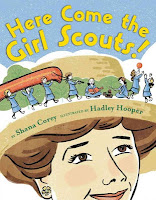Have you seen
Sarah Bean Thompson's Caldecott Storytimes series? When I saw her latest installment, I decided I had to focus on illustrations in my February outreach. Our local schools are in the midst of Caldecott and Newbery projects right now, so my supplies of Caldecott titles are low, but I grabbed a few other books with beautiful illustrations, all different from one another, and headed to the preschools. Here's how it went.
Opening Song: "
Open, Shut Them"
 Story: Chu's Day
Story: Chu's Day by Neil Gaiman, illustrated by Adam Rex
Before I began this first story, I introduced our theme for the day: looking closely at the pictures in books to get more from the story.
Chu's Day is a shorter story text-wise, but Rex's illustrations add so many layers of richness. I invited children to shout out what they saw in the big picture spreads where Chu is at the library, the diner, and the circus. I included some leading questions to help them see how pictures can fill out details in a story. One example was in the diner spread, where I asked if they could tell who was the chef. We looked for the chef's hat and finally found the whale behind the diner counter. All these small details felt like new discoveries to the kids--discoveries that added to the story.
 Story: The Duckling Gets a Cookie!?
Story: The Duckling Gets a Cookie!? by Mo Willems
I shared the cover of this book and asked the kiddos if the pictures looked as detailed as our previous story. Willems's relatively sparse style adds its own flair to his stories, especially the characters of Pigeon and Duckling. The kids love Pigeon's overdramatic responses to everything, and they particularly enjoyed looking at the spreads where Pigeon rattles on about all the things he's asked for but not gotten. And the black steam/rage cloud above Pigeon's head at one point? They loved that and commented on it.
Wiggle Rhyme: "Three Sailors Went to Sea"
Even though I was inviting comments from kids throughout the first two stories, I could tell they were getting wiggly from sitting still. Thus I broke up our session with a wiggle rhyme that
Ted from Your Magic Storytime Hat recently reminded me about. We did actions (making waves with our arms for "sea" and putting our hands above our eyes for "see") and repeated the rhyme several times, trying to get faster each time.
Three Sailors Went to Sea
Three sailors went to sea, sea, sea
To see what they could see, see, see
But all that they could see, see, see
Was the bottom of the deep blue sea, sea, sea!
 Story: You Will Be My Friend!
Story: You Will Be My Friend! by Peter Brown
I think Brown's illustration style represented a great middle ground between Rex's rich detail and Willems's expressive minimalism. In this story, Lucy Bear is eager to make a new friend--but she has a rather hard time doing that, what with her distinct personality. One of the beauties of this book, in my opinion, is that the pictures are vital to getting the whole story. That fact invites plenty of talking about what readers/listeners can see in the pictures before I turn the page. My kids were really starting to enjoy talking about what they saw, and they fell into a rhythm of knowing when it was time to quiet down so I could turn the page.
 Story: Max Found Two Sticks
Story: Max Found Two Sticks by Brian Pinkney
For our last story, we talked about how things in the pictures can hint about what is going to happen next in a story. In this book, Max finds two twigs and decides to make music with them by drumming on all manner of objects. He finds the sticks while his grandfather is washing windows; in the next spread, we see Max drumming on the wash bucket. After his friends show up drinking sodas out of glass bottles, the next spread shows Max drumming on those bottles. By the end of the story, my kids were able to guess what Max would be drumming on next. I also really love sharing this story because it can be interactive--I ask kids to stick out their two pointer fingers to be their own sticks, and they can drum and tap along to the rhythms in the text. Lots of fun all around.
Closing Song: "If You're Happy and You Know It"
I always worry that the kiddos are growing tired of ending our story times with this song, but that's not yet been the case. This time I pulled out the ukulele and asked the children to remember some of the animals we saw in our stories to fill the verses of the songs. My favorite was when they wanted to be pandas like Chu--they decided it was best to pretend to chomp on bamboo if you're happy and you know it and are being a panda.
~~*~~
What are some of your favorite books to share and talk about illustrations?



































